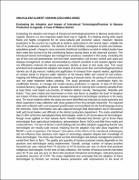| dc.description.abstract | OBUKULEM ALBERT ASEIKIN (2010-MI52-20050)
Evaluating the Adoption and Impact of Introduced Technologies/Practices in Banana Production in Uganda: A Case of Wakiso District
Evaluating the adoption and impact of introduced technologies/practices in Banana production in Uganda. Banana is a very important staple food crop in Uganda. It is leading among other staple foods and highly recognized for its socio-cultural and economic values. However, Banana production in the country has continued to decline, particularly in the central region, initially the hub of its production overtime. The decline in the soil fertility, emergence of pests and diseases, population growth, change in socio-economic livelihood conditions as sited in related studies have been noted and proved to be the contributing factors among others to this observed scenario. The introduced banana technologies and management practices, evaluated in this study, including the use of low-cost soil amendments; soil and water conservation; soil erosion control and; pests and diseases management, as earlier recommended by research scientists in and outside Uganda, have not effectively reversed the banana production decline at least in this study area. This study prioritized and evaluated the adoption and impact of at least seven low cost technologies/practices namely use of pig manure, making and application of compost from organic wastes; application of contour bands to improve water retention in the banana fields and control of soil erosion, trapping and killing adult banana weevils, chopping of pseudo stems, the paring of corms/suckers and hot water treatment before planting. The study perceived this combination fairly for smallholder farmers, to manage and sustain banana production in Uganda. A total of 200 (two hundred farmers), regardless of gender, educational level or training were randomly sampled from at least three rural based sub-counties of Wakiso district namely; Namayumba, Masulita and Kakiri. They were visited and interviewed on their own farms to establish the level of adoption and impact of these selected introduced banana management technologies /practices in the study area. Ten local residents within the study area were identified and inducted as study assistants and these supported in data collection with close guidance from the principle researcher. The required data were collected with a pre-prepared questionnaire and translated into the local language during the interview. Some information was also captured through field observations and in discussions held with local leaders and officials at the district production department. The study established that 37.85% of farmers had adopted these technologies, while 51.5% knew about the technologies, though never applied on their banana farms. Results indicated that farmers got to know these technologies from agricultural institutions, demonstration farms, NGOs and little from media and contact farmers. The size of farmer’s land holdings did not affect adoption suggesting that the new technologies are mostly scale neutral, implying that the adoption may take place regardless of farmer’s scale of operation. The farmers‟ perception of the effects of the introduced technologies did not influence their decisions with regard to technology adoption despite their knowledge of those technologies. The study also found out that technologies and banana management practices varied from farm to farm. The quality and quantity of banana produced mainly depended on the practices and technologies being implemented. Overall, average number of banana bunches harvested per year reduced from 73 bunches to 67.25 bunches per acre on farms that practiced indigenous technologies. At the time of data collection, the number of banana bunches harvested were 82.75 per year per acre on farms that practiced introduced technologies, indicating banana production recovery of 9.75% The study established and concluded that the adoption of these technologies by farmers can increase banana production with improvement in the level of
adoption. This is as demonstrated by the above recovery potential found with a few farmers found applying these technologies. There is need to intensify promotion of these technologies and practices to scale out adoption with farmers. This is regardless of the debates for or against genetic modification of the naturally existing banana cultivars. Government established institutions/programmes like NARO and NAADS should strengthen linkages and partner more with other stakeholders in the country to enhance farmer institutional capacity building to make introduced interventions more farmer friendly and farmer owned all through the production value chain for greater outcomes of their efforts to sustain banana production in Uganda and to optimise sustainable outcomes from ongoing research in the country.
Key words: Banana, Technologies, Production | en_US |


